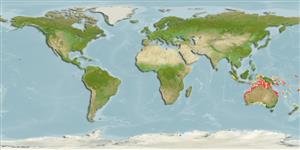>
Atheriniformes (Silversides) >
Atherinidae (Silversides) > Craterocephalinae
Etymology: Craterocephalus: Greek, krater, -eros = bowl, mixing vessel + Greek, kephale = head (Ref. 45335).
Environment: milieu / climate zone / depth range / distribution range
Ekologi
marina; brackvatten bottenlevande. Tropical
Western Pacific: Abrolhos Islands, Western Australia to Gulf of Carpentaria, Northern Territory, Australia.
Size / Vikt / Age
Maturity: Lm ? range ? - ? cm
Max length : 8.5 cm TL hane/ej könsbestämd; (Ref. 9760)
Taggstrålar i ryggfenan (totalt) : 5 - 7; Mjukstrålar i ryggfenan (totalt) : 6 - 8; Taggstrålar i analfenan: 1; Mjukstrålar i analfenan: 7 - 10. Gill rakers short, with spinules, 1-13 on first lower gill arch. Anus very close to origin of fin. Second dorsal fin with I spine, 6-8 rays; anal fin with I spine and 7-10 rays. Midlateral scales 29-33.
Essentially an estuarine species and coastal species, co-occurring with C. pauciradiatus, C. mugiloides and Atherinomorus endrachtensis. Biology not known except that it can withstand very high salinities. Probably taken as food by larger commercial species. (Ref. 9760).
Life cycle and mating behavior
Könsmognad | Reproduktion | Lek | Ägg | Fecundity | Larver
Ivantsoff, W. and L.E.L.M. Crowley, 1999. Atherinidae. Silversides (or hardyheads). p. 2113-2139. In K.E. Carpenter and V.H. Niem (eds.) FAO species identification guide for fishery purposes. The living marine resources of the Western Central Pacific. Volume 4. Bony fishes part 2 (Mugilidae to Carangidae). FAO, Rome. (Ref. 9760)
IUCN Red List Status (Ref. 130435: Version 2024-1)
Threat to humans
Harmless
Human uses
Fiskeri: saknar intresse
Verktyg
Special reports
Download XML
Internet-källor
Estimates based on models
Preferred temperature (Ref.
123201): 21.8 - 28.5, mean 26.9 °C (based on 258 cells).
Phylogenetic diversity index (Ref.
82804): PD
50 = 0.5000 [Uniqueness, from 0.5 = low to 2.0 = high].
Bayesian length-weight: a=0.00389 (0.00180 - 0.00842), b=3.12 (2.94 - 3.30), in cm total length, based on all LWR estimates for this body shape (Ref.
93245).
Trofisk nivå (Ref.
69278): 3.0 ±0.4 se; based on size and trophs of closest relatives
Resiliens (Ref.
120179): Hög, lägsta populationsfördubblingstid mindre än 15 månader (Preliminary K or Fecundity.).
Fishing Vulnerability (Ref.
59153): Low vulnerability (10 of 100).
